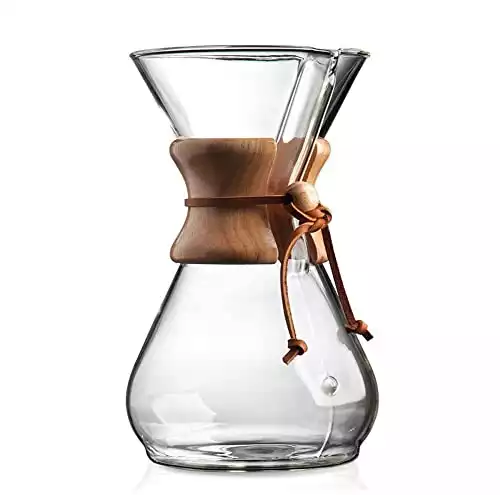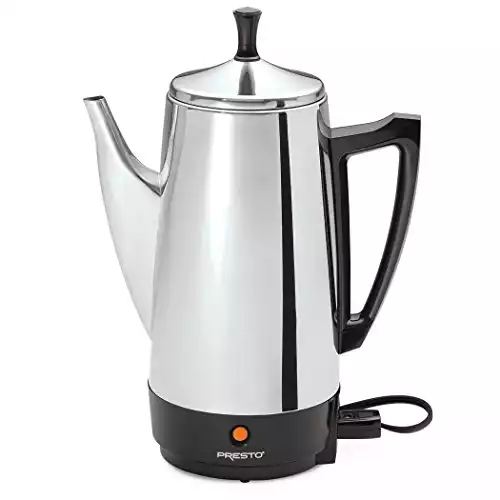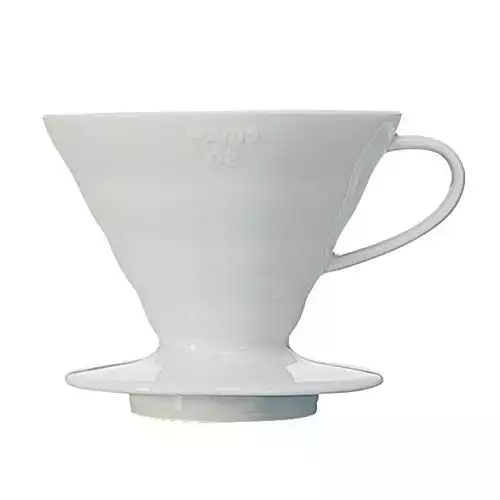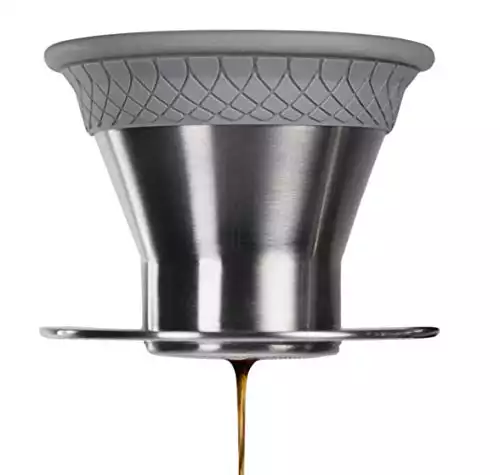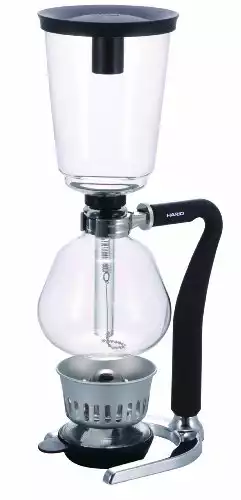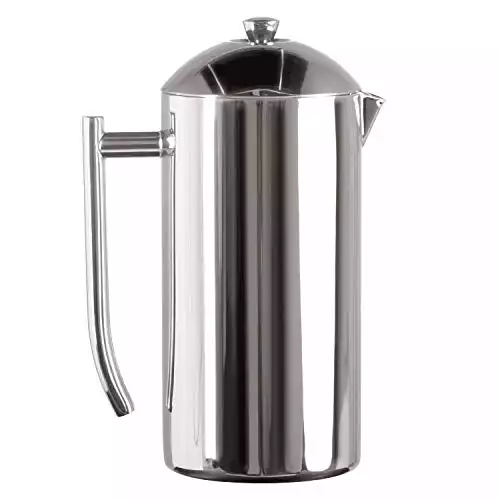Best Plastic free coffee maker
When sipping on your coffee, the last thing you want to think about is if your brew has been contaminated by plastic seeping through.
Thankfully, you can completely avoid this issue by grabbing a plastic free coffee maker. Yes, they’re less common and reduce the number of drinks you can make on average.
But hey, you’re here because you’re part of the tribe now, the one which says screw the plastic coffee maker! Now, before we jump in with the deets if you’re just after a recommendation here’s our top picks:
An essential for any lover of manual brewing. A simple but effective way to brew incredible coffee right at home.
Why BPA Free Coffee Makers Are Worthwhile
BPA is an abbreviation of Bisphenol A, an industrial type of chemical found in plastic containers. It keeps things cheap and helps make them sturdy. In a way that’s less prone to breakage.
From toys, containers, and furniture, Bisphenol A is a universal additive to common items. The problem begins when it’s used in things that store food or drink, including coffee.
When food packaging contains Bisphenol A, you run the risk of contamination. Exposure to heat and acids can break down a plastic coffee maker and food containers with each use. As you ingest microdoses on a daily basis, you also increase the health hazards that BPA plastics bring into your body.
How exactly do you ingest Bisphenol A?
The good (and bad) news is that you mainly ingest it orally. Through your diet and the habits surrounding it.
Aside from being a component of plastic containers, BPA is also used as a lining for canned food and jar caps. This is to keep metal that comes into contact with food from corroding. So it could be easy to avoid with the proper habits. But for some, a total lifestyle change is in order to not come in contact with BPA.
What are some of the negative effects of BPA on humans?
Whenever BPA gets into our system, there are many different ways it can slowly make us sick. According to researchers, the most adverse effects are on young people, such as babies and toddlers. Increased risk of metabolic and hormonal ailments can be directly correlated with exposure. Some endocrine and fertility-related disorders can also result from high levels of BPA in your system.
BPA In Coffee Makers
You brew with your coffee maker regularly. If your plastic coffee maker isn’t BPA-free, you can imagine how much you’re exposed to this harmful chemical in your daily cup of coffeel. The heat from water and acids from the beans work together to constantly break down BPA from the walls of your coffee maker.
You may feel like you got a bargain in the short-term but a cheap plastic french press coffee maker won’t be doing you good long-term.
On top of this, you’ll often have an issue with flavor.
Have you tasted hot water (wait for it to cool down first) from a plastic container versus hot water from a glass or stainless steel cup? There’s always an added chemical-like taste from non-plastic-free coffee containers. Some of that’s potentially BPA. A similar reaction takes place in your coffee maker, some of it is just masked by your brew.
To test this, if you drink plain water from a plastic cup, you’ll perceive a different taste when compared to say ceramic. No matter how well you wash it. The same thing happens with the parts of your coffee maker that come into contact with the brew itself. You could potentially waste those top-quality coffee beans you get just because the flavors from your usual blend will seep into your brewer.
Now that we’re more aware of these hazards, let’s take a look at some of the best non-toxic coffee makers in the market today. At least think about a shift in material whether it’s a french press coffee maker, a drip coffee maker, or a pour-over coffee maker.
Best Plastic Free Coffee Makers 2021
1. Chemex Coffee Maker
Let’s start you off with one of the most timeless zero plastic coffee makers of all time: the Chemex.
It was engineered (literally) to help brewers arrive at ideal coffee extraction each time they made coffee. So every curve and angle down to the shape and size of the opening serve a purpose.
An essential for any lover of manual brewing. A simple but effective way to brew incredible coffee right at home.
PROS (+)
- Made of borosilicate glass that is toxin-free and odorless
- Beautifully designed
- Incredible for a fruity cup of coffee
CONS (-)
- Not good if you’re after body not acidity
- Requires a specific type of filter
The Chemex is made up of a borosilicate glass carafe with a wooden neck. This allows you to handle it even when the contents are piping hot. It’s known to produce a balanced, clean, flavorful cup of coffee. This is the result of the paper filter and the coarser grind you’ll need to apply.
Why coarser?
It’s made to brew multiple cups at a time. So your regular presets for pour overs might be too tight for this coffee maker, while a French Pressed grind might be too coarse. This factors into the signature profile of coffee from this multi-cup coffee maker.
In my opinion, this is one of the all-time greats in the category of non plastic coffee makers. It also falls under pour-over coffee makers that are completely toxin-free. It’s best for those who need at least 3-4 cups of coffee brewed daily. This is a personal range recommendation if you want to maximize the size of the glass carafe and the disposable filters you’ll need to brew with the Chemex.
It comes at a hefty price compared to plastic alternatives but you’re paying for the quality of coffee it can produce. Tasty and free of BPA.
Also, in the event that you form a crack that renders it unusable, it’s still a beautiful flower vase to have around your house or cafe. It’s definitely a must-have coffee maker for those who hand-brew!
2. Hario V60 Ceramic Coffee Dripper
If you’re looking to get serious about your coffee, this next brewer is for you. The V60 coffee maker is one of the most accessible and reliable drippers for this method. It’s simple to use, easy to clean, and easy to replace. But you’ll rarely have to replace this plastic free coffee maker.
The pour over king (or queen)! If you enjoy light roasts and are picky about your brew, this one’s a perfect pick!
PROS (+)
- Ceramic keeps the temperature consistent
- Flexible enough to be used with any roast
- Easier to use than the Chemex
CONS (-)
- Brews only 1-2 cups of coffee at a time
- Filters can become expensive
It’s a staple in your coffee arsenal if you’re a fan of pour over coffee brewers. Nonetheless, If you’re coming from a drip set up, you’ll notice the improved balance in your cup right away.
There is no question that the Hario V60 is my second favorite coffee maker without plastic. It comes in a variety of colors and finishes. From ceramic, glass, and stainless steel, choose according to your preference.
Remember to pre-wet your paper filters with water to rinse off the paper taste. That means you need to add an extra 100ml of water you’ll be prepping for your brew. The ideal ratio of beans-to-water is 1:15. Start with that, and see what works for you.
3. Presto 12-Cup Stainless Steel Coffee Maker
In terms of internal movement, the percolator is the total opposite of drip coffee makers. The movement of your coffee is downwards with a drip brewer.
With percolators, your water is pushed up by pressure coming from high temperatures. It then goes through the filter with coffee grounds, then backs down into the coffee maker. A non-BPA free coffee maker wouldn’t be ideal for this setup.
PROS (+)
- The stainless steel body is the most durable material for brewing
- Easy to clean, easy to use
- Can make anywhere from 2-12 cups of coffee at a time
CONS (-)
- No control over the brewing process
- Can’t make 1 cup of coffee at a time
The stainless steel finish of the Presto is perfect for withstanding the high brew temperatures of this coffee maker. You won’t find plastic parts that come into contact with your brew, which is what qualifies it to be part of our “BPA-free coffee maker” list. Plastic-free parts mean pure, full-flavored cups.
When it comes to use, this coffee maker is pretty straightforward and it’s predictable in terms of flavor. It produces a bit of a heavy-bodied, dark brew. Now, this isn’t going to win any awards but If that’s how you like your coffee, this is a good pick for you.
More generally, percolators are similar to drip brewers in the sense that you only need to push a button to get your coffee brewing. If you want low activity brewing and a consistent cup, this could be an option for you to rotate between your regular drip brewer.
No pro tips needed here, the signal light will tell you when it’s time to drink your coffee!
4. Espro Bloom Pour Over Coffee Maker
This is an interesting plastic-free coffee maker concept. “SPRO” comes from espresso. It seems to be a reference to the special reusable filter that this brewer uses. Quite a deviation from the usual one or two holes that drippers have.
Espro Bloom Pour over Coffee Maker
PROS (+)
- Rubber and stainless steel material makes it highly durable
- Modern design
- 2-minute average brewing time
CONS (-)
- Only makes a maximum of 2 cups per batch
- Makes more of a thick pour over rather than an actual espresso
It’s hard to replicate the conditions in an espresso machine with no automated help. So it’s best to set your expectations accordingly with this pick.
An increased surface area with a more proportionally sized “exit” for coffee will put emphasis on technique. But if you get it right, the science is sound with this brewer in terms of yielding a good extraction.
Compared to French Press, Pour-Over, or Drip brewers, you do get a thicker brew with the SPRO. While It won’t stack up against an actual espresso brewed with an espresso machine, the SPRO can get you a step closer.
It’s also easy to use and easy to clean. One of the best concepts in the new age of plastic-free, stainless steel coffee maker options.
The bonus? It’s purely stainless steel in the main area where H2O and coffee interact. No plastic parts. The non-stainless steel part is rubber. So yes, it’s a completely BPA plastic free coffee maker.
5. Hario NEXT Glass Syphon Coffee Maker
Drip is one of the easiest brewing methods while French press is one of the most common. Chemex is one of the most classic i-love-fruity-coffee makers. That makes siphon one of the most beautiful BPA free coffee makers to use. It looks great. It’s also complex in the best ways step-by-step.
PROS (+)
- Classic, elegant design
- One of the more fun brew methods to master
- Glass carafe is toxin-free
CONS (-)
- A more tedious method in terms of brewing and clean up
- Prone to breakage during cleaning
It works like a percolator, except that you can control the heat source. Movement starts in the water reservoir, up to the bean chamber, then back down to the server. The beauty comes out in seeing the entire process happen. It is a plastic free coffee maker after all so the glass parts are see-through.
In terms of workflow simplicity this is the total opposite of a drip brewer. But for satisfaction it’s top of the list. Personally, It’s a method that’s been fun to figure out and master. There are mixed reviews on cup quality though, so the only way to really decide is to try it yourself.
Outside the pour over method, this is my favorite. I enjoy the craftsmanship, showmanship and the variables that are within your control. It’s also one of my favorite brewers to look at in any setting. Definitely a worthy consideration as your next (or first) plastic free coffee maker. Stainless steel is more durable but these glass options and without question looks better.
If you have endless curiosity you can play with your variables a bit with the Syphon. It’s one of the most iconic BPA free coffee makers. The parts are easy to maintain as well so longevity isn’t out of the question with proper handling either.
6. Frieling Stainless Steel BPA Free Coffee Maker
Technology and knowledge in coffee is always evolving. Just like in any other industry. Brewing principles are constantly tested and examined. Equipment is constantly upgraded to reflect these new learnings. Enter the double-walled, stainless steel, double-filtered french press.
PROS (+)
- Stainless steel brewers are almost bullet-proof in terms of durability
- Double-walled means it’s well-insulated and cool-to-touch
- 2-stage filtering gives you a smoother french press experience
CONS (-)
- Heavy, so it can be a hazard to other breakables while washing
- Some factory defects have been reported a few times
French presses are characterized by a heavy body. A single metal filter lets fines slip into your coffee, resulting in a thick cup of joe. It’s easy to use, and even easier to purchase from almost anywhere. It’s an immersion type of brewer, so your carafe is exposed to heat for the duration of your extraction
Now, if you’ve got a plastic heavy French Press which is in contact with the warm brew, you’ll potentially end up with more than just a bit of BPA seeping through.
Now, with a movement steering away from BPA, there’s a focus on stainless steel construction quality. Before you decide on the best plastic free coffee maker, examine build quality.
Especially if it’s stainless steel. Check the welding on crucial areas like the handle, the lid, and the filter. No matter what material, coffee makers need getting used to. They need to last long enough to be mastered.
With Frieling, you can relax. This is a premium build French Press coffee maker which does all the right things.
More generally, Immersion brewers are a good case for BPA free coffee makers. Hot liquid isn’t just passing through! It’s constantly there until it cools down or gets consumed. Whichever comes first.
This is why the double-walled coffee maker by Frieling has the potential to save home brewers from burning themselves. It’s cool to touch.
The double-filter design also gives coffee from this press a light body. The result is a touch closer to a pour over rather than an immersion method.
If this piqued your interest, consider this BPA free coffee maker as your next upgrade!
Plastic Free Coffee Makers Buying Guide
Plastic Free Coffee
Let’s face it. The menu is pretty short when it comes to non BPA free coffee maker options. They’re either expensive or limited. Your options are a bit tight, especially if your budget is tighter.
You might have noticed from the list above, it’s easier to come across BPA free coffee maker options with hand-brewing methods. So if you’re curious about being more in control of your coffee, now could be a good time to make the switch.
But, no coffee bargain is worth it if there’s a heavy downstream price to pay. This makes the choice to avoid BPA easy. It’s not as easy to decide to switch to a BPA-free coffee maker, but it’s worth it.
Consider adjusting your budget a bit to allow you to invest in a brewer which allows you not to worry. Your coffee is part of a daily routine, so it wouldn’t be wrong to invest in things you will keep by your side for years to come.
Coffee Without Plastic Might Require Effort
Outside of french presses and pour overs, manufacturers seem to choose plastic as part of a coffee maker carafe. It can be easy to work with (durability) but it can also be scary. BPA shouldn’t be taken lightly given that it can be found anywhere. The solution is to choose a method where you can still make coffee your way, but in the least harmful way possible.
If you’re willing to make your coffee manually, you will have enough BPA free coffee maker options out there already. You’ll get better tasting cups of coffee, and improved piece of mind by going BPA-free.
The Final Verdict
Between glass and steel, I prefer glass. As a professional barista, I’m used to handling delicate pieces of coffee equipment. Neither have BPA. But so many other kitchen and bar items do.
From our list above the Chemex is the best plastic free coffee maker out there for me. It’s pure glass, so it’s BPA free. It’s an exercise in preparation, efficiency, precision, and consistency. This happens daily as you make coffee.
An essential for any lover of manual brewing. A simple but effective way to brew incredible coffee right at home.
While yes, you do need specific paper filters, It’s still the most beautiful glass coffee maker option to use and watch. With the right workflow you can definitely produce amazing cups of coffee on repeat without worrying about plastic parts touching the coffee.
Try it for yourself. See if there’s compatibility between the BPA-free brewer and how you like your coffee regularly. Most of all, enjoy and keep brewing.

